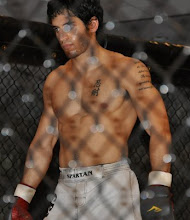STRENGTH AND CONDITIONING FOR THE COMBAT ATHLETE
By Mike Campanella
PART I – The Philosophy of Combat Training
Ask any successful combat athlete (wrestler, boxer, MMA fighter, etc.) how they achieved their level of success and more often than not they will mention their strength and conditioning program as being an integral part of their preparation. Simply realizing this fact, however, may do more to hurt an aspiring fighter than help them in preparing for a future in the sport. I say this because without proper guidance, and in conjunction with all of the training information that exists on the Internet today, it is very easy for athletes to do the wrong things, suffer from “paralysis by analysis,” or even give up altogether.
While the previous scenario regarding unguided athletes is troubling, there also exists another group of athletes who remain stuck in the mire of “old-school” training methods where roadwork, thousands of push-ups and sit-ups, and/or bodybuilding dominates their training schedules. These sorts of training regimens directly lead to decreased performance and unfulfilled potential. In light of all this, it is my aim to point all of these aforementioned athletes in the right direction when it comes to strength and conditioning for improving performance in combat sports.
The main goal of any legitimate strength and conditioning program for the combat athlete is, without a doubt, to achieve sport specificity. “The principle of specificity states that the results of a training program will be directly related to the type of training performed” (Fleck, S.J., and W.J. Kraemer). This is true because “the muscle activation patterns and oxygen requirements among exercise modes are not equal, so the responses and adaptations are not equal” (Bressel, E., G.D. Heise, and G. Bachman). In other words, “training that involves one mode of…exercise will not guarantee equal improvement with a different…exercise mode” (Ben-Ezra, V., C. Lacy, and D. Marshall). What does this mean in laymen’s terms? A boxer who hits the heavy bag for conditioning will reap greater benefits than one that does endless roadwork. In essence, all workouts and exercises done in the weight room or training facility should mimic the skills and movements that are needed to be successful on the mats or in the ring. So even though jogging two miles may provide some benefits from an aerobic conditioning standpoint, hitting the heavy bag, a much more sport specific activity, will ultimately provide greater dividends.
Now that we have established the importance of sport specificity, we must establish which facets of strength and conditioning the combat athlete should focus on, as well as how he/she should go about improving those skills. To start, every combat athlete should focus on the following parameters when developing a practical strength and conditioning program: strength, strength endurance, explosiveness (power and speed), explosive endurance, muscular endurance, anaerobic conditioning, and aerobic conditioning. Furthermore, and once again alluding to the principle of sport specificity, these seven facets of strength and conditioning should be trained by using and moving the body. To accomplish this, the majority of workouts should be total body in nature, the majority of exercises should be total body compound movements, and all movements should involve moving the entire body, as one would during his/her competitions.
Finally, and perhaps most importantly with respect to novice athletes, every combat athlete should first be able to adequately control their own body through bodyweight exercises before any external apparatus is used. Once proficiency in moving the body has been established, equipment such as kettlebells, dumbbells, barbells, medicine balls, bands, weighted vests, etc., can be used for more effective training and greater improvement in the combat arena.
In the next section, I will discuss the beginning stages of program design and how one can begin to train these seven facets of strength and conditioning.
Thursday, November 26, 2009
Subscribe to:
Post Comments (Atom)

No comments:
Post a Comment